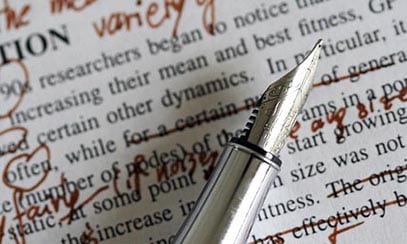
You’ve pushed through the creative process to write a great piece for a client. It’s the end of the day, and you’re dreading the next steps. You’ve done the fun part—the research and gathering of information. You even have some awesome quotes.
If you thrive during the writing process but really dread the tedious work required to edit appropriately, you’re not alone. Good editors are methodical, detail-oriented and efficient—meaning they have mastered a system over time that works well for them.
If you don’t have access to a professional editor, then you will have to buckle down and take on the task yourself. But don’t despair. It’s rewarding to have a good editor, but it’s even more empowering to become your own.
Here are some quick tips that you can use to take the responsibility of editing into your own hands.
Step 1: Make the story exceptional.
You’re beyond fact checking at this point, so this doesn’t mean verifying information as a journalist would. Let go of reading each little sentence in the piece and look at the story you’ve just written. How does your story begin and end? What details do you need to add or leave out? Good stories often offer a powerful lead, a clear plotline and usually a finite conclusion.
But put yourself in the shoes of an 8-year-old child listening to a story for the first time. What kind of story keeps a child on the edge of his or her seat? Children respond to exceptional stories by taking action. They choose Halloween costumes based on compelling characters. They line up at bookstores with their parents to buy the sequel. They act out scenes again and again because they are fascinated with what happens. So, did you write an exceptional story?
Step 2: Scrutinize the structure.
We typically have no more than 15 seconds to capture readers online—and goldfish have longer attention spans than our readers. So scrutinize structure. This means editing at the paragraph level. Paragraphs—or in some cases simply chunks of information—are stories within a story. And chunks should be small. Successful paragraphs can be as short as two sentences.
On the other hand, you need enough substance to creatively connect the pieces of the larger story you identified in Step 1. Here are some questions to ask yourself as you examine the smaller chunks independently and how they fit together.
- Is the thought or idea in each small section complete?
- Do you lead your reader logically from one idea to the next? Are transitions smooth?
- Is there enough variety? Does each chunk feel new or refreshing in some way?
- Does each chunk add to the natural progression of the narrative, or are some tangential or superfluous?
Step 3: Refine the sentence.
Mark Twain once said, “The difference between the right word and the almost right word is the difference between lightning and a lightning bug.” He’s right. And the fastest way to kill a story is to make it difficult to read. Take the time to look at each sentence. Make this the final step in the editing process—you’ll be in a more relaxed and creative space to pay attention to the finer details.
First, did you use active voice? The fastest way to improve readability is to eliminate the use of passive voice or use it only when necessary. Next, check your sentence length. Short sentences work best. But also note that a variety of sentence lengths can make a piece read more smoothly.
Once you have edited for active voice and sentence length, examine word choice. Ask yourself: Is each word interesting? Eliminate jargon and other words that are too complex—but keep words interesting. You can now check for AP Style mistakes and make sure hyperlinks are in the correct places.
Finally, polish for grammar and punctuation. Don’t feel confident in this area? There are a number of websites to help you out, including Grammar Girl and Grammarly.com.
You may be thinking that you don’t get to write about exciting topics all the time…or that what you do get asked to write is only within the confine of 140 characters. The same editing steps can still apply. How can you look at that press release about floor wax with a new set of eyes? One might argue that it’s even more important that you get that story, structure and sentence just right.
Julie C. Lellis, Ph.D. is an associate professor and associate chair in the School of Communications at Elon University. See julielellis.com or follow Julie: @julie_lellis


This 356688.com domain name is for sale.
If you would like, please email:
[email protected]